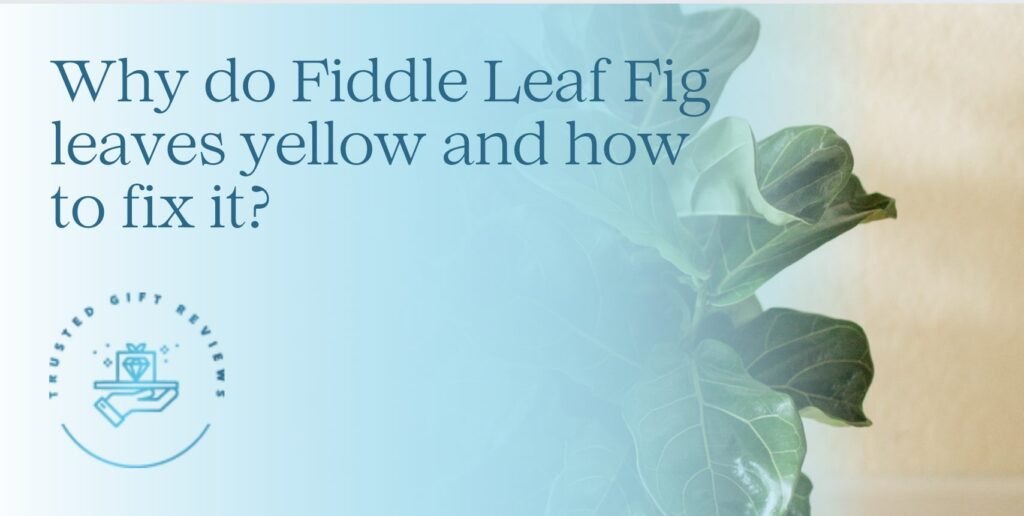The leaves of fiddle leaf figs can yellow due to the following reasons:
- Overwatering
- Inadequate sun
- Nutrient deficiency
- Plant disease
- Pest infestation
To fix them, you have to modify your care habits or repot the plant completely.
Let us explain more about these common issues and the solutions for them. Later on, we will also teach you how to repot this plant and prevent these issues in the future as well!
How to Fix Yellow Fiddle Leaf Fig Leaves


Below is a table summing up the treatments for fiddle leaf figs whose leaves have yellowed:
What do yellow fiddle leaves mean?


Yellowing fiddle leaf fig leaves can signal
- lack of water
- excessive watering
- lack of nutrients
- poor light conditions
- incorrect temperature and humidity level
- pest infestation
- Plant disease
How do I know if my fiddle leaf fig is too dry?
Fiddle leaf fig cells need water to keep their leaves pristine and upright. If it lacks water, this will show in drooping or falling leaves.
In some cases, the leaves will curl inward or have brown spots appearing on their edges. This tells you that the plant is craving water and it’s not getting enough now.
Though the fiddle leaf fig can be drought-tolerant like the snake plant, it still needs its share of water when its roots and soil have dried.
How to Fix an Underwatered Fiddle Leaf Fig
A fiddle leaf fig needs watering once every week or ten days. Don’t water it any sooner than that, but allow the soil to dry out completely before you water it again.
What happens if you overwater a fiddle leaf fig?


When you water the fiddle leaf fig more than it needs, it traps water and moisture in the soil.
Since it is drowning, the plant’s defense mechanism automatically kicks in. So the roots stop absorbing water and oxygen altogether greatly hindering its growth.
If not tended to immediately, the excess water will breed fungi and damage the roots resulting in the plant’s loss of vigor and stunted growth as well as yellowing leaves.
How do you tell if a fiddle leaf fig is overwatered?
You can tell that your fiddle leaf fig has been overwatered if you see brown spots or patches in the middle or along the margin of the leaves.
Other signs that take longer to show up are yellowing, drooping or wilting leaves, and unexpected slower growth.
How do you fix an overwatered fiddle leaf fig?
If you’ve poured too much water on your fiddle leaf fig, remove the murky standing water and let the water drain out of the pot holes or better yet, repot it completely in new potting soil.
How to Tell if Your Fiddle Leaf Fig Is Nutrient-Deficient


One common sign that your fiddle leaf fig is nutrient-deficient is yellowing leaves.
Another is stunted growth. It can’t develop and grow beautifully if it isn’t getting ample essential nutrients.
How to Fix a Nutrient-Deficient Fiddle Leaf Fig
You can improve your fiddle leaf fig’s nutrient uptake with fertilizer and organic, moist, and well-draining soil.
If you have forgotten when you last applied fertilizer to your fiddle leaf fig, it’s probably time to do it again.
Feed it with a high-nitrogen fertilizer (like one with a 3-1-2 NPK count) once during the summer. However, leave it be during the winter when it is inactive.
Besides that, check if you have the proper soil for your fiddle leaf fig. It prospers in organic, moist, and well-draining soil.
And it’s crucial for the soil to be lightly acidic to neutral with a pH value of 6 to 7.
How do you know if a fiddle leaf fig is not getting enough light?


First off, you can begin to suspect your fiddle leaf fig isn’t getting enough light if it is located in a shaded or dark spot in your home or office. It’s a dead giveaway.
But the more subtle signs include the plant having yellow leaf undersides, slow growth, grayish matte spots, strange environmental reactions, small new leaf growth, or leaning toward the window.
How much light should my fiddle leaf fig get?
A fiddle leaf fig needs five to six hours of direct morning to noon sunlight indoors and up to eight hours outdoors.
Western, southern, or eastern-facing windows are good for this light exposure. Place the plants at a distance of up to 3 feet from them.
Can fiddle leaf figs get too hot?


Although fiddle leaf figs prefer warmer temperatures, prolonged exposure to strong sunlight can still damage them.
While it can point to a different but related issue, like overwatering, the fiddle leaf fig demonstrates that it’s not comfy with its ambient temperature if its leaves shift to yellow or brown or strangely fall off.
Leaves will also dry up and turn brittle if the plant’s environment lacks moisture.
How to Fix a Fiddle Leaf Fig Experiencing Weather Stress
To keep your fiddle leaf fig from further weather stress, put it someplace with 60℉ to 75℉ and 70 to 90 percent humidity.
However, if your house just cannot achieve these desired conditions, you could just keep the fiddle leaf fig in a greenhouse for a conducive and controlled environment.
What is eating the leaves of my fiddle leaf fig?


Here are some of the common pests that inflict harm or damage to fiddle leaf figs:
- Aphids
- Mealybugs
- Scales
Some of them suck out the sap, and others leave holes and webbing in their path.
These are the signs that these pests are on your fiddle leaf fig:
- Aphids – These can be seen as small green colonies marching on or crawling up the leaves or new stems. They can make the leaf wilt and yellow.
- Mealybugs – They are white cotton insects that frequent the bottom of the leaves and leaf joints.
Female mealybugs can lay up to a hundred eggs per sac, and this can easily spiral out of control on your fiddle leaf fig.
Yellowing or dying leaves and stunted growth are the possible signs that the plant has been infested by mealybugs
- Scales – These insects are small, brown, and oval-shaped and cause the fiddle leaf fig to yellow or wilt. They are aggressive pests, and their damage can be so dire that the plant won’t be able to recover from it.
How do I get rid of fiddle leaf fig bugs?
In general, neem oil diluted with water sprayed onto harmful fiddle leaf fig pests will get rid of them.
Alternatively, you can use rubbing alcohol-drenched cotton or a mild pesticide and insecticide to eliminate them for good.
For badly damaged plants or plant parts, it would be best to disinfect and dispose of them because chances are the plant cannot recover and the insects can jump onto other plants nearby.
Common Fiddle Leaf Diseases


A diseased fiddle leaf fig can get different symptoms, including yellowing leaves.
The three most common illnesses of fiddle leaf figs are
- Root Rot – This is a fungal health problem wherein the roots get attacked. Oftentimes, it’s overwatering the plant that causes this.
- Edema – This can be caused by 1) overwatering or irregularly watering the plant, 2) growing it in a tight space, and 3) fertilizing it irregularly.
When you grow them in a pot container that’s too small, it deprives them of proper airflow.
- Bacterial Wilt – This illness invasively enters the leaves through their stomata and causes many yellow and brown spots to appear on them.
What does a diseased fiddle leaf fig look like?
Common signs of sick fiddle leaf figs are yellowing leaves and brown spots.
Signs of Root Rot on Fiddle Leaf Figs
It’s quite easy to detect root rot in a fiddle leaf fig. Just look for brown or black spots on the leaves, both on their top and bottom sides, and brown and mushy roots and stems.
Since root damage is caused by having too much moisture, the plant or its roots will emit an unpleasant rotten odor too.
Signs of Edema on Fiddle Leaf Figs
To tell whether your fiddle leaf fig is struck by edema. Check for yellow or white lumps or bumps on the foliage which indicate that its internal cells have burst.
Signs of Bacterial Infection on Fiddle Leaf Figs
If you want to check your fiddle leaf fig for bacterial infections, look for mushy, brown roots and stems.
With this disease, the plant may also have leaves with irregular brown spots ringed with yellow and strangely shaped or torn foliage.
How do you treat a sick fiddle leaf fig?
Luckily, you can still save your fiddle leaf fig from diseases like root rot, edema, or bacterial infection.
Often, the best treatment for a diseased fiddle leaf fig is to 1) separate and throw away the affected parts and 2) repot the healthy parts in new and correct potting soil and a clean pot
In doing this, refrain from watering the repotted plant until after a week. Place it in a cooler place to allow them to recover slowly and surely.
How to Repot a Fiddle Leaf Fig


- Fill the new pot vessel with 4 inches of soil.
- Gently tilt and remove the fiddle leaf fig from its current pot.
- Place the plant in new potting soil.
- Water it generously.
- Allow excess water to drain out from the holes underneath.
- Fertilize the plant after one month.
It’s necessary to do this if your fiddle leaf fig has been overwatered.




